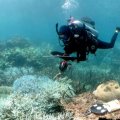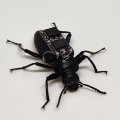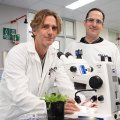A collaborative university-industry-government project has developed a new tool to help land managers better manage domestic and wild animals on their properties.
The system can distinguish between sheep, goats, cattle, horses, pigs, kangaroos and emus and has application for other species and uses.
The technology has already attracted international interest and a team in the USA is currently testing its ability to identify North American species.
The new tool results from a joint project between The University of Queensland (UQ), the University of Southern Queensland (USQ), the Australian Government and RPM Rural Products.
Dr Peter Murray and Mr Neal Finch from UQ's School of Animal Studies have spent the past four years refining and implementing a computerised system, using Machine Vision Technology (MVT).
The system identifies animals and controls their movements through automated gates to access watering or feed points.
Mr Mark Dunn from USQ has worked closely with the project team to develop the computer technology.
The MVT system can be used to control the loss of feed and water to feral animals and increase farmers’ productivity and efficiency in remote areas.
“In this environment [where a typical property can cover thousands of hectares], if you can control the water, you control the animals,” Mr Finch said.
On large properties in remote areas, farmers were often unable to monitor which species were using the resources provided for livestock, he said.
Feral goats and pigs, and an overabundance of native emus and kangaroos can put enormous pressure on the available feed and water and, if unchecked, can increase in numbers to pest proportions. This can significantly impact both on production and on natural resources in the environment.
Up to now, farmers have had to rely on lethal techniques such as shooting, poisoning and trapping to manage pest animals. The MVT technology aims to prevent the artificial build up of feral populations so that introduced and native animals do not become pests.
Managing animals at watering points is not new. Trapping and self mustering systems have been around for a long time. The difference with this technology is its ability to discriminate between species.
The miniaturised, energy efficient hardware running the MVT software can also read Radio Frequency Identification (RFId) ear tags which allows for individual animals to be recognised.
The researchers said MVT had the potential to increase the tasks currently undertaken manually in the rangelands without requiring extra labour, for example, automated drafting based on species or RFId ear tags.
Weight estimation and condition scoring of livestock, combined with monitoring and management of wildlife are all now possible with this technology.
The Australian Government, through the Departments of Agriculture and the Environment and Water Resources, has provided over $600,000 from the Natural Heritage Trust to assist the development and trial phases of the project.
Media inquiries: Susanne Schick - UQ Gatton Campus (5460 1229, 0409 265 587). Further information/comment: Contact Peter Murray (5460 1256, peter.murray@uq.edu.au)
.jpg)



